Listen to the audio version of this story:
OAKLAND, Calif. — Vida Mendoza is only 14, but she hopes to vote in two years.

Mendoza is a member of the student-led Oakland Youth Vote campaign, which advocates for giving 16- and 17-year-olds the right to vote for school board representatives. In May, the Oakland City Council voted unanimously to put the initiative on the November ballot.
Mendoza, a freshman at Life Academy in Oakland, said her school board must be held accountable to the district’s 36,000 students, 85 percent of whom are people of color, and ensure that all of its schools are “getting the resources they need.”
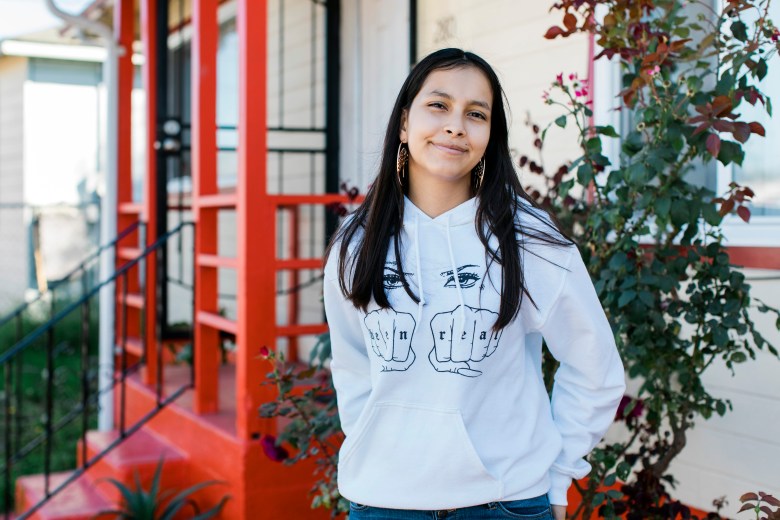
“Who is the school board really representing?” said Mendoza. “Are students of color getting represented appropriately and are decisions being made to support them and their learning?”
In recent years, students have led climate marches, gun control rallies and walkouts protesting federal immigration policies and racial injustice. Now they are demanding a greater role in school policy and the decisions that shape their educations.
Some school districts, local governments and nonprofit groups across the country have galvanized this youth activism by giving students opportunities to participate in leadership roles and democracy in ways that go beyond civics classes and student government. They are also seeking to use this moment to educate teens about elections and voting and turn them into lifelong voters. Despite indications that youth are increasingly involved in civic life, voter turnout among 18- to 24-year-olds remains stubbornly low, and many young adults say they don’t know the basics of how to register to vote and cast a ballot.
Rebecca Kaplan, Oakland city council president and author of the measure to enfranchise 16- and 17-year-olds in school board elections, said it will have “both the immediate goal of letting young people have a say in the school board decisions that are so important for them, but also really a strategy to build our democracy and to build participation and civic involvement for the long haul.”
“The reality is that in most school governance systems, young people are systematically marginalized … and students play absolutely no role.”
Andrew Brennen, National Geographic education fellow
Andrew Brennen, a National Geographic education fellow working with youth-led movements, said efforts to empower students in school districts such as Oakland are refreshing, but nationwide, there’s a lot more work to be done.
“The reality is that in most school governance systems, young people are systematically marginalized,” he said, “and students play absolutely no role.”
Related: Students have their own demands for school reopening
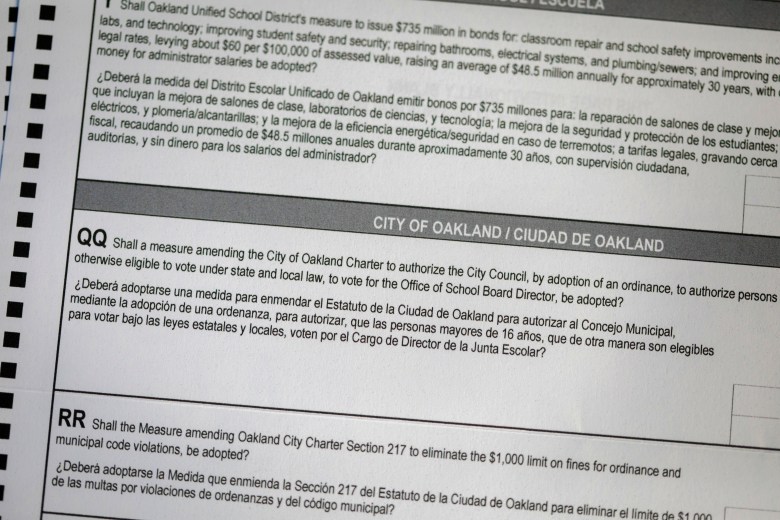
Mendoza’s involvement in civic participation started in middle school, when she signed up for the All City Council Student Union, a student-led group sponsored by the Oakland school district that gives students a voice in school district decision-making. In that role, she visited schools around the city and was shocked by the disparities in school building facilities and resources, she said.
Every year the group chooses an issue to focus on. In recent years, the group’s advocacy has led to changes in the district’s graduation requirements, to align them with admissions requirements for California’s university systems, and an expansion of funding for an after-school meal program that had been cut by the school board.
The Oakland Youth Vote, listed on the November ballot as Measure QQ, is one of the latest causes the All City Council has taken up. For this effort, they have teamed with community organizations and the Oakland Youth Advisory Commission, a group convened by the city to consult on policy issues.
“Who is the school board really representing? Are students of color getting represented appropriately and are decisions being made to support them and their learning?”
Vida Mendoza, high school freshman, Oakland, California
The idea to lower the voting age came about following the Oakland teachers’ strikes in February 2019, according to Lukas Brekke-Miesner, executive director of Oakland Kids First, one of the nonprofits involved in the campaign. Students had marched in solidarity with teachers but were upset when the school board slashed funding for several of their demands — for restorative justice programs and foster care case managers — during the contract renegotiations with the teachers’ union, he said. These cuts, coupled with students’ ongoing frustrations over successive reductions in critical services, helped inspire the All City Council and Oakland Kids First to join forces to launch the youth vote campaign in fall 2019 as a way to hold the school board accountable to young people in the district, Brekke-Miesner said.
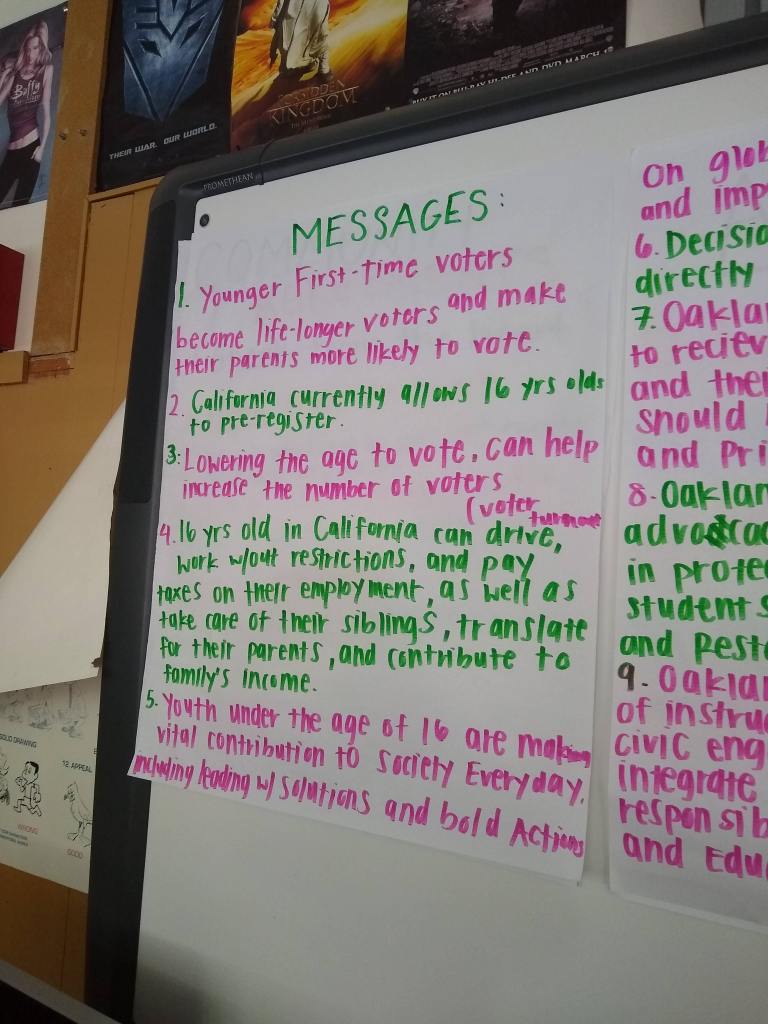
Christian Castillo, a senior at Coliseum College Prep Academy, has been part of that effort, as a member of All City Council. He said he wasn’t interested in politics before joining the council this year. “Being politically to the right or left, or like having an opinion on it, sort of never really applied to me,” he said. “There was always other people to do it … so I believed I didn’t have to.” Now he’s lobbying his friends who are old enough to vote by informing them how they and their community would benefit if the Oakland Youth Vote passes.
Through All City Council, Oakland students have a louder voice in local education policy than students in many cities, but young people say it’s not enough. The council’s two student directors serve on the Oakland Board of Education in an advisory capacity and regularly meet with their adult counterparts. That’s an increasingly common model in both districts and states: Kentucky, for example, recently created its first student position on the state board of education. But even in districts and states that include student board representatives, students rarely have voting power.
Jessica Ramos, a senior at Skyline High School and a student director on the Oakland school board, she is treated as “just being a teenager” — asked to take on many adult responsibilities like working, paying taxes or taking care of family members, but denied any real power. “Things … the government does affect us, but we can’t vote,” she said.
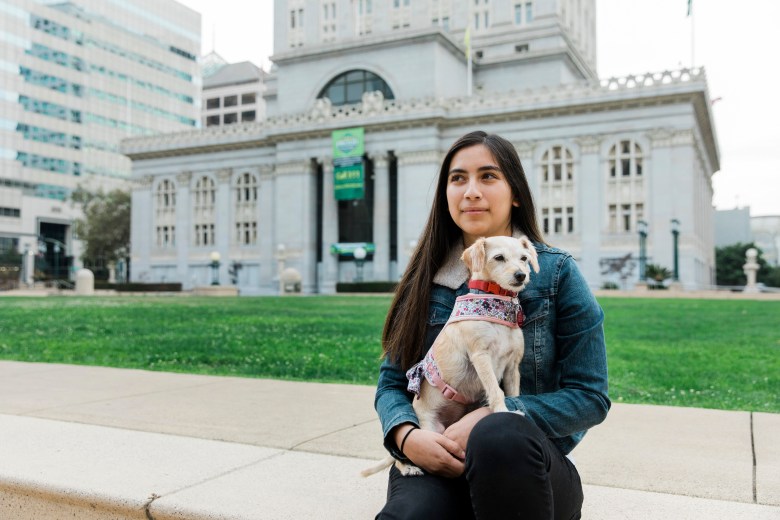
Oakland student directors are able to cast an advisory vote, reflected in the official record. But Ramos said “it doesn’t really count. It’s just an opinion.”
A handful of states, including California, Massachusetts, Tennessee and Vermont, do allow student representatives full voting rights on state boards of education. Massachusetts is unique in that the student board representatives are elected by their peers. Mendoza’s older sister, Gema Quetzal, served on the California board of education in 2018-19, enjoying the same voting power as other board members.
Now she’s a sophomore at Stanford University and is helping to do voter outreach for the Oakland Youth Vote. “As a voting member, I felt I could hold adults accountable for the decisions they made on the education of my peers across the state,” she said. “I also could give the perspective of what students see in their schools every day.”
Related: Making America whole again via civics education
Other school districts are also trying to elevate student voices in education policy and avoid “tokenism,” as Cristina Salgado puts it. She was hired as the student voice specialist at Chicago Public Schools in 2012 to oversee the district’s newly created “student voice committees.”
Students who serve on the committees learn how to research, organize and identify solutions to issues in their schools, said Salgado. The committees are different from traditional student government, she said, because any student can join. Committee members were among the students leading a walkout in the wake of the 2018 mass shooting at Marjory Stoneman Douglas High School in Parkland, Florida; students on the committee are also focused on teaching their peers about organizing effectively and understanding the reasons for the protests. Chicago students have also helped shape school district discussions on school infrastructure, attendance and the hiring of a new high school principal.
“Teaching about civic engagement only once in a while is like teaching someone how to swim without ever putting them in the water.”
Heather Van Benthuysen, director, Chicago Public Schools Department of Social Science and Civic Engagement
The committees are housed within the Chicago school district’s social science and civic engagement department, which promotes civic engagement in and out of the classroom through K-12 social studies curriculum, service learning and civics-focused project-based learning.
One of the department’s main goals is to educate students about democracy and the electoral process — and not only during an election year — said director Heather Van Benthuysen. “It’s not just about getting out the vote, it’s about talking about, learning about electoral issues, discussing and elevating issues in the community, engaging with elected officials and ensuring they represent you,” she said. “Teaching about civic engagement only once in a while is like teaching someone how to swim without ever putting them in the water.”
In early October, the district held a virtual event to train high school students from wards with particularly low voter turnout rates to do election outreach. Students learned about topics such as mail-in voting, local elections and how the pandemic could affect turnout. Later they analyzed voter turnout data in their neighborhoods and developed plans for educating younger peers, family members and neighbors about elections.
Brenda Casas, a 16-year-old junior at Tilden High School, in Chicago, said she’d started getting interested in politics after taking a civics class last year. But it wasn’t until the virtual workshop that she learned how to talk to others about the benefits of voting. After the event, she decided to broach the topic with her mother. “I was trying to convince her because she’s one of the people that doesn’t want to vote because they don’t trust the system,” Casas said.
Other districts and states have also started to promote hands-on civics education. In 2018, Massachusetts passed a bill that required districts to ensure every eighth grader participates in at least one student-led, nonpartisan civics project, and New York City Public schools hired its first “student voice manager” in 2019. This election cycle, many elections offices have teamed up with high schools to recruit students as poll workers. In Montgomery County, Maryland, 16- and 17-year olds can receive service learning hours as an election aide.
Related: What happens when students are given a say in school budgets?
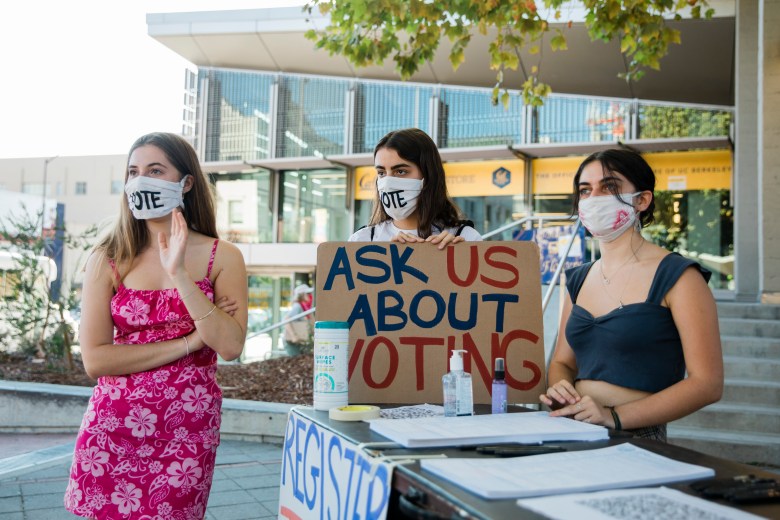
Meanwhile, Oakland isn’t the only city to attempt to lower the voting age for local elections. At least three cities in Maryland have extended voting rights in local elections to 16- and 17-year-olds, and a handful of states and other cities have explored the idea. In 2015, Generation Citizen, a nonprofit, launched a national campaign to extend voting rights to teens in local elections.
Berkeley voters passed a measure in 2016 that gave the city council authority to allow 16- and 17-year-olds to vote for school board members, but it stalled out amid financial and technical hurdles. The measure barred the city from spending any money on implementation, and since voting occurs at the county level, the logistics of a separate ballot for 16- and 17-year-olds in Berkeley has been complicated.
“So many of the obstacles that we’ve faced are just a result of the fact that Berkeley is one of the very first cities in the entire country to do this, and the only one in California, so there’s no precedent for how to do this,” said Adrienne Mermin, a senior at Berkeley High School who has been pushing for implementation,
Proponents of Measure QQ, in Oakland, hope to avoid such red tape if the measure passes. The Oakland City Council is committed to funding and implementing the measure if it is approved, said Kaplan, Measure QQ’s author.
Mermin said if Oakland’s measure passes she expects it will put pressure on the city of Berkeley and surrounding Alameda County to lower the voting age. She said one reason 18- to 24-year-olds don’t vote is they are in the midst of big life transitions, such as entering college and the workforce. Casting a ballot in high school would familiarize students with the process at an earlier age and lead to higher turnout, Mermin said.
That’s held true in Takoma Park, a Maryland town of 18,000 near Washington, D.C. In 2012, it became the first U.S. city to lower the voting age to 16 for local elections. The turnout for 16- and 17-year-olds in local elections between 2013 and 2017 averaged roughly 42 percent, compared with 20 percent overall, according to data from the city clerk’s office.
“They basically behave like 70-year-olds,” said former city councilman Timothy Male. Teens ages 16 and 17 are also showing up at city council meetings, organizing candidate debates in Takoma Park and holding voter registration events, he said.
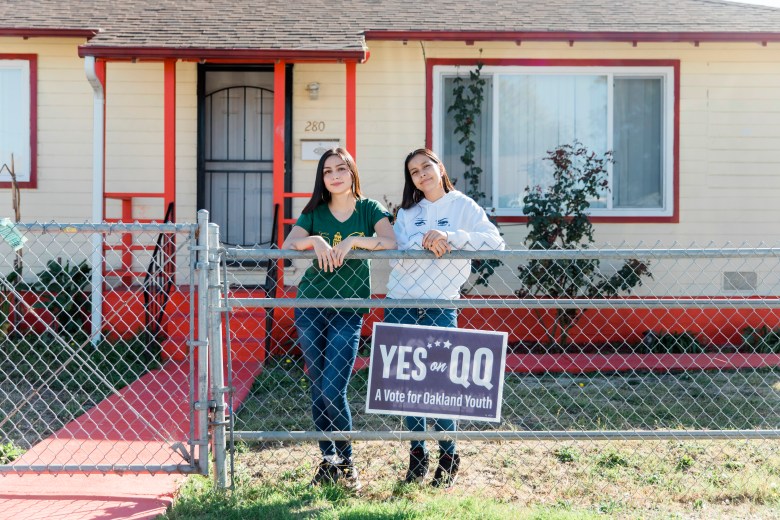
Back in Oakland, students have been working through the pandemic to ensure the ballot measure will succeed. In May, almost a dozen students called into a virtual Oakland City Council meeting to advocate for it. They have organized a phone- bank campaign and, in early October, hosted a virtual launch event on Facebook Live featuring student speakers and live performances by local artists and musicians.
Brekke-Miesner, of Oakland Kids First, said he has seen how being involved in policy making changes young people. Students who were once terrified of speaking before council members now command the room, he said. “They’re so much more effective organizers than any of us as adults are, because they have way more on the line, and they know these issues in a really deep experiential way,” he said.
If Measure QQ gets the nod on November 3, it would enfranchise an estimated 8,000 16- and 17-year olds in Oakland.
Vida Mendoza, the Life Academy freshman, is looking forward to 2022 when she could be among those teen voters. Mendoza argues that it isn’t complacency that keeps young people from the polls, but the failure of schools to educate youth about the mechanics of voting and how they can make a difference.
Her passion for activism came from watching her mom and sister organize in the community, but she credits the All City Council with giving her a platform.
“You go to school to learn,” she said, “but you can also learn what is going on beyond your classroom.”
Update: On November 3, Measure QQ passed in Oakland with 67 percent of voters casting their ballots in support of lowering the voting age for school board elections to 16.
Monica Braine produced the audio segment for this story.
This story about youth activism was produced by The Hechinger Report, a nonprofit, independent news organization focused on inequality and innovation in education. Sign up for Hechinger’s newsletter.
This story has been supported by the Solutions Journalism Network, a nonprofit organization dedicated to rigorous and compelling reporting about responses to social problems.



